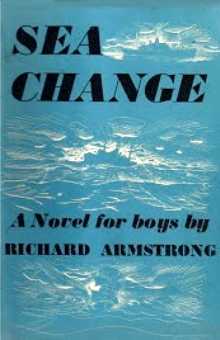Sea Change (Armstrong novel) facts for kids

Cover of first edition
|
|
| Author | Richard Armstrong |
|---|---|
| Illustrator | Michel Leszczynski |
| Country | United Kingdom |
| Language | English |
| Genre | Children's realistic novel, sea story |
| Publisher | J. M. Dent |
|
Publication date
|
1948 |
| Media type | Print (hardcover, paperback) |
| Pages | 222 pp (first edition) |
| OCLC | 1116022 |
Sea Change is an exciting adventure novel for young people. It was written by Richard Armstrong. The book was first published in 1948. It tells a realistic story about life at sea.
The main character is a sixteen-year-old boy named Cam Renton. He is an apprentice in the British Merchant Navy. This means he is learning to become an officer on a ship. Cam has already spent one year at sea. He needs to complete four years of training. He hopes to earn his second mate's ticket. However, he is not always sure if this life is for him.
Richard Armstrong knew a lot about life at sea. He spent 17 years working on different types of ships. He started his own sea career at the same age as Cam. Sea Change won the important Carnegie Medal. This award is given to the best children's book by a British subject each year.
Contents
Cam's Adventure at Sea
Cam Renton has been a seaman apprentice for one year. He arrives in Liverpool to join a new ship. It is called the Langdale. This is a cargo ship that carries goods. The ship is heading to Barbados and the Spanish Main. Cam dreams of becoming an officer and even a captain one day.
Cam feels his training is not going well. He asks the Chief Mate to assign him to a night watch. This is instead of his usual day-work. The mate is not happy with Cam's request. They often disagree during the voyage.
Cam feels treated unfairly. He tries to play a trick on the mate. He makes it seem like a whistling poltergeist is haunting him. But Cam soon realizes this idea is silly. It will not help anything.
Shore Leave and Lessons Learned
When the ship reaches the Caribbean, Cam gets a rare chance to go ashore. He visits Boca del Sol, a made-up port city. Cam and his bunkmate, Rusty, get into trouble. They end up in the local prison after a misunderstanding. Cam makes a daring escape from prison.
However, Captain Carey, the ship's captain, already has the situation under control. He talks to Cam honestly. The captain helps Cam see that he is getting excellent training. This is thanks to the mate, even if Cam doesn't realize it.
After this, Cam starts to work and study seriously. His skills in navigation and semaphore become very useful. He even joins a small crew on a salvaged derelict. This is a ship that was found abandoned and saved.
Who Are the Crew?
The Langdale has a crew of thirty-eight members. Here are some of the important characters:
- Campbell "Cam" Renton: A sixteen-year-old apprentice seaman.
- "Rusty" Roberts: Cam's friend and fellow apprentice. They share a bunk.
- Captain Carey: The wise captain of the Langdale.
- Andy: The chief mate of the Langdale. He is tough but fair.
- "Happy" Hartland: The cheerful Cornish second mate.
- The third mate: Another officer on the ship.
- The bosun: The ship's foreman, in charge of the crew.
- "Chippy" Rasmussan: The ship's carpenter. He is a gentle giant from Scandinavia.
- The ship's cook: A talented banjo player who makes meals for the crew.
- "Calamity" Calston: An able seaman. He always predicts bad things will happen.
- "Bandy" Boscombe: Another able seaman.
- "Taffy": A sailor from Wales.
- The commandant: The leader of the fort and soldiers in Boca del Sol.
Why This Book is Special
Sea Change was the first book written especially for boys to win the Carnegie Medal. The story mainly features male characters. It takes place almost entirely on a ship at sea. This was a very traditional setting for adventure stories.
The book focuses on the work of the ship. It also shows how the crew members interact. It teaches about growing up and taking responsibility. The story highlights how trusted adults guide Cam's training. It shows how he learns to be a capable young man.
Many people see Sea Change as a very realistic sea story. It does not focus on romance or fantasy. Instead, it shows the real challenges and rewards of life at sea. The author, Richard Armstrong, wanted readers to feel confident in their own abilities. He wanted them to feel ready to live a full life in the real world.
The book is also special because it deeply explores Cam's character. Armstrong understood how a young man thinks. He skillfully shows Cam's good nature. He also shows Cam's struggle to understand the world around him.

